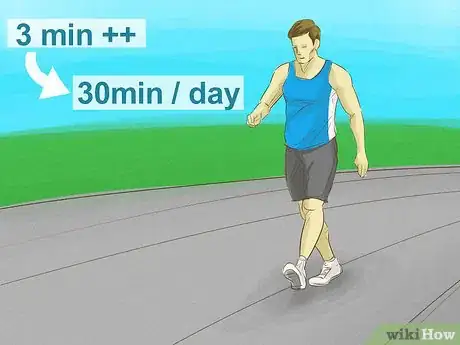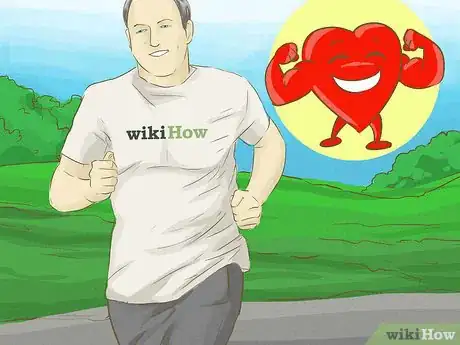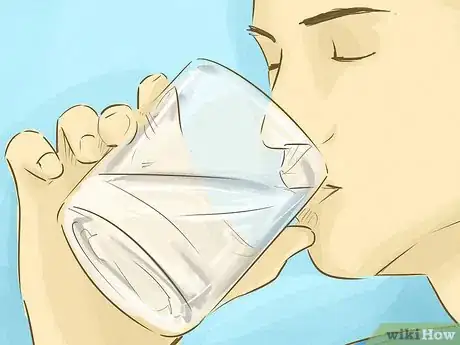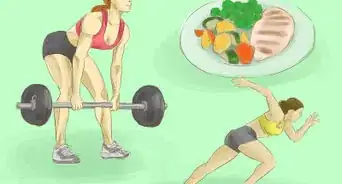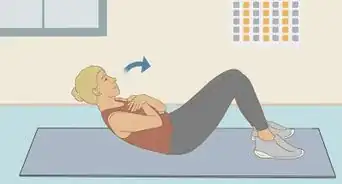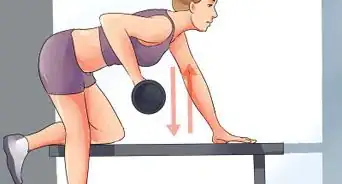This article was co-authored by Francisco Gomez. Francisco Gomez is the Head Coach at the FIT Potato Gym, a training gym established in 2001 in the San Francisco Bay Area. Francisco is a former competitive runner who helps endurance athletes train for major marathons like the Boston Marathon. Francisco specializes in Injury Rehab, Flexibility, Marathon Training, and Senior Fitness. He has a B.S. in Nutrition and Exercise Physiology & Running.
There are 16 references cited in this article, which can be found at the bottom of the page.
This article has been viewed 34,720 times.
While the duration of your workout depends on your goal, the American Heart Association has a general recommendation of physical activity for 30 minutes per day, five times a week to improve cardiovascular health.[1] For many, working out for 30 minutes (or longer) may prove difficult. Whether you’re training for a marathon, attempting to lose weight, or just being more health conscious, there are ways to increase the duration of your workout to ensure you’re meeting your goal. Keep in mind techniques used by beginners trying to add minutes to their cardio time may be different than those used by veteran exercisers trying to take their workout to the next level.
Steps
Training Your Brain
-
1Set a goal. Before you aim to increase the duration of your workout, you have to know what your end goal is and how you will get there. Set a goal that is SMART: Specific, Measurable, Attainable, Realistic, and Timely.
- For example, set a goal to add two extra minutes to your workout, five days a week. Once that’s attained, you can revisit your goal and opt for five extra minutes five days a week.
- Or, say you ran a half marathon last year, and this year you want to run a full marathon. Set goals to work up to the full 26.2 miles. Your goal for your first week of training might be "Run six days a week, a total of 33 miles."[2]
-
2Use visualization exercises. Visualizing the benefits of a behavior can be used as a motivational strategy to push you to keep going.[3] Acceptance and commitment therapy (ACT) can help you push through a workout by learning that negative feelings associated with working out aren’t good or bad; they’re just a part of life.[4] Try pushing through the thoughts and focus on the outcome instead.
- Use an ACT technique such as holding an ice cube and paying attention to the thoughts that go through your head as the ice cube becomes uncomfortable. Although it may be cold, numb, or painful, avoid dropping the ice. Relate this experience to your workouts by knowing that even when your legs feel tired or you’re out of breath, discomfort is temporary. It is necessary for a short time, but it will stop and the outcome will be worth the temporary discomfort.
- You can also visualize the end result of an action. For instance, visualize how the sun will feel shining down on you after you run the length of the trail, or imagine how proud you will be when you see your muscles developing. Or imagine the sense of accomplishment you'll feel crossing the finish line after you complete the marathon.[5]
- It’s important to not only visualize obstacles, but to put in place a plan for overcoming them. For example, if you tend to stop running because your shins are burning, look into a new pair of shoes or compression sleeves that will help with the pain.
Advertisement -
3Try positive reinforcement. Positive reinforcement is when you reward yourself for good behavior. Your brain begins to link the reward to the behavior and realize that the behavior is worthwhile. In turn, your behavior becomes a habit or second nature, and you’ll be increasing your endurance without even knowing it. Over time, you won’t even need the outside motivation because your brain will begin to associate sweat and pain with endorphins or “feel good” chemicals.[6]
- Make sure, too, that you're encouraging yourself with positive self-talk. Instead of focusing on how far to go, or any setbacks you may encounter, think about your successes. You might say something like, "Wow, I am really pleased I did that extra five minutes. I guess I really can do it. I'm succeeding at this!"
- Reward yourself by hitting the sauna, buying new workout music, or sleeping in five extra minutes.
- Your brain will begin to recognize that the workout itself is a treat, and your body and brain will be more inclined to work out for longer periods of time.
-
4Sign a contract. Think of this as a promise you make to yourself. You can do this in many ways such as signing a contract in front of friends that will hold you accountable or making a contract with yourself. The important part is that there has to be some type of penalty for not reaching your goal — and that you follow through with any consequences. Whether it’s the embarrassment of not living up to your word, or a monetary penalty you assess yourself, a contract can help to establish a cost associated with your goal.[7]
- Research shows that people are more likely to follow through on promises when they are made in front of others, so get your friends involved in your goal to add more time to your workout.
- You can also make your penalty monetary by agreeing to pay a friend or donate money to an organization anytime you don’t increase your workout time as planned. (It can be extra motivating to have your friend donate money to an organization you do not support when you don't follow through on your workouts.)
- Try using apps that track your goal and progress. For example, there are apps that not only pay you for reaching your goal, but also penalize you if you don’t.
Training Your Body
-
1Talk to your doctor about supplements. Supplements are snacks, drinks, shakes, or pills that people use to complement their diet and bridge gaps in nutrition for peak performance.[8] Examples include caffeine, branched-chain amino acids (BCAAs), or pre-workout supplements. The purpose is to increase energy and defy fatigue which will help you push through your workout.[9]
- If you are just looking for a little boost to keep working out a few minutes longer, try caffeine. Caffeine is known to increase energy, focus, and drive but should only be used in correct dosages. Research suggests taking 1.5–2.5 milligrams per pound of body weight. Caffeine can be purchased at your local health and nutrition store or can be ingested naturally through drinks such as coffee, decaf coffee, and tea.[10]
- Some experienced exercisers take BCAAs. BCAAs provide the body with amino acids which prevent muscle breakdown and allow muscle tissues to be used as a source of fuel. It is specifically used to maintain intensity during training sessions. BCAAs can be purchased at your local health and nutrition store or from online vendors.[11]
- Pre-workouts can be purchased at your local health and nutrition store or online. Find the right mix of ingredients that help in edging out fatigue by speaking to sales associates or reading online reviews.
-
2Time your sugar intake. Though most people think of sugar negatively, a little bit of sugar can provide the extra spike in energy that you need to push yourself to work out longer.[12] Through a process known as Cellular Respiration, your body breaks down the chemical bonds in sugar to release stored energy into your body.[13]
- Keep in mind that consuming too much sugar can lead to an increase in body fat.
-
3Eat a balanced meal before your workout. About 60–90 minutes before your workout, consume a meal that is high in carbohydrates and lean protein. This pre-workout meal will be used to power your body through energy-depleting workouts.[14]
- For example, try a tortilla wrap (carb) with grilled chicken (protein) and mixed veggies before your next workout.
- If you measure your nutrients each meal, try to consume about 25 percent of your carbs for the day during your pre-workout meal.
- The grams of protein and carbs needed vary based on each individual, each workout, and each fitness goal. To determine your needs, visit a nutritionist. Additionally, many websites offer approximations of macronutrients (fat, carbohydrates, and protein) based on height, weight, and age.[15]
-
4Make sure your body is well-rested. Though it sounds obvious, it is important to avoid working out when you are highly fatigued. If you are tired, it is far less likely that you will be able to build your endurance and work out for longer than usual. So instead of hitting the gym after standing on your feet all day at work, try to squeeze your exercise in before work.[16]
- This advice can also be used after tough workouts. If your body has yet to recover from a workout the day before, don’t push it. Take a rest day so you’ll be better prepared to push your body to work out longer.[17]
-
5Stay hydrated. Hydration is often overlooked when it comes to extending the duration of one’s workout. Not only does it impact your overall health, but just like nutrition, it determines whether your body is functioning at its prime condition.[18] More specifically, staying hydrated helps to combat muscle fatigue and boost endurance. Always drink water before, during, and after your workout to replenish fluids lost during exercise.[19]
- Try to drink one to two glasses of water an hour or two before you work out, one to two immediately following your workout, and one cup for every 20 minutes of intense activity.
- You can also drink sports drinks or electrolyte beverages to replace lost electrolytes and maintain healthy potassium and sodium levels. Just keep in mind that sports drinks usually contain a lot of sugar.[20]
Distracting Yourself from Your Workout
-
1Pick a workout you enjoy. Trying to extend the duration of an activity you hate is difficult to achieve and maintain. So choose an activity that you consider enjoyable: running, swimming, hiking, biking, dancing, and many more. By focusing your attention on the fun you’re having, you’ll focus less on the duration of the activity.[21]
- Many sports clubs offer a variety of group classes that can help you determine the types of exercises you consider to be fun.
- There are also many social clubs that focus on fitness. These clubs combine fun athletic activities and you can also make some like-minded friends who have similar goals.
- You can try changing your routine. When people get bored of the same routine they tend to stop pushing themselves. Change up your cardio, add weights, or try cross training.
-
2Grab a workout buddy. Not only has research proven that those who exercise with friends improve their weight loss results, but it’s also generally known that fitness pals help to boost motivation.[22] Working out with a partner can force you to push beyond your limitations to crank out those few extra steps or reps. Invite a friend, family member or co-worker to join you on your fitness journey.[23] Even if they don’t work out with you, they can still hold you accountable.
- If a friend or family member doesn’t come to mind, try websites like Living Social or Meetup.com to link up with individuals with similar fitness goals and interests.
-
3Watch something or read something. Studies have shown that visual cues can influence one’s performance during exercise. Visual cues can “trick” your brain so exercise feels easier even if it actually isn’t. So consider positive visuals and words that will help your brain focus on positivity instead of perception of effort.[24]
- A study showed that people who were shown positive words and smiley faces were able to work out an extra six minutes (or more) in comparison to people who were shown negative words and sad faces.
- This study demonstrated that people’s exercise limits were based on their perception of effort, not muscle fatigue. In other words, it is all in your mind, so stay positive and continue to push forward.
-
4Listen to upbeat music. Music is a great motivator when it comes to exercise. Listening to your favorite tunes or something really upbeat or motivating can increase endurance and may make your workout seem easier. You may work out longer without even realizing it.[25]
- You will unconsciously want to synchronize your movements with the tempo of your music, so an up-tempo song may have you running a little faster.[26]
- Listening to music you love may help with your mood and make it easier for you to push through a difficult workout.[27]
- There are some apps that will match the tempo of your music to your pace.
-
5Stay active. The more you work out the easier it becomes, so create a routine and avoid straying from it. Try exercising at least five days a week, and attempt to increase your duration little by little until you can consistently exercise for 30 minutes or more. Regular exercise will help fight fatigue and improve stamina and endurance.[28]
- A sedentary lifestyle has a direct effect on your energy level so try to be active throughout the day. Walk instead of driving to nearby places, take the stairs instead of the elevator, and take quick stretch breaks at work to remain limber.
- Try buying a pedometer to track how many footsteps you take per day.
-
6Work at it little by little. Change doesn’t occur overnight so set a realistic goal and work at adding more time to your workout one workout at a time. This is called gradual adaptation, where you are required to be consistent, patient, and build up to your goal slowly. "Slow and steady wins the race," so gradually build up to your goal.[29]
- For example, even if you can only run for 30 seconds at a time, stick to it. Run for 30 seconds and walk for a few minutes, repeating the cycle until you reach your goal duration of time. Repeat this a few times during the week. The following week, try to add 15–30 more seconds to each cycle. Before you know it, you’ll be running 30 minutes at a time.
Expert Q&A
Did you know you can get expert answers for this article?
Unlock expert answers by supporting wikiHow
-
QuestionHow long is too long for a workout?
 Francisco GomezFrancisco Gomez is the Head Coach at the FIT Potato Gym, a training gym established in 2001 in the San Francisco Bay Area. Francisco is a former competitive runner who helps endurance athletes train for major marathons like the Boston Marathon. Francisco specializes in Injury Rehab, Flexibility, Marathon Training, and Senior Fitness. He has a B.S. in Nutrition and Exercise Physiology & Running.
Francisco GomezFrancisco Gomez is the Head Coach at the FIT Potato Gym, a training gym established in 2001 in the San Francisco Bay Area. Francisco is a former competitive runner who helps endurance athletes train for major marathons like the Boston Marathon. Francisco specializes in Injury Rehab, Flexibility, Marathon Training, and Senior Fitness. He has a B.S. in Nutrition and Exercise Physiology & Running.
Fitness Coach It totally depends on your level of fitness, the type of workout, and the intensity of your activity. In general, it's always better to play it safe if you feel like you're pushing it too far or too hard. If you feel like you're in pain or on the verge of injury, it's time to call it quits for the way.
It totally depends on your level of fitness, the type of workout, and the intensity of your activity. In general, it's always better to play it safe if you feel like you're pushing it too far or too hard. If you feel like you're in pain or on the verge of injury, it's time to call it quits for the way. -
QuestionHow can I run longer?
 Francisco GomezFrancisco Gomez is the Head Coach at the FIT Potato Gym, a training gym established in 2001 in the San Francisco Bay Area. Francisco is a former competitive runner who helps endurance athletes train for major marathons like the Boston Marathon. Francisco specializes in Injury Rehab, Flexibility, Marathon Training, and Senior Fitness. He has a B.S. in Nutrition and Exercise Physiology & Running.
Francisco GomezFrancisco Gomez is the Head Coach at the FIT Potato Gym, a training gym established in 2001 in the San Francisco Bay Area. Francisco is a former competitive runner who helps endurance athletes train for major marathons like the Boston Marathon. Francisco specializes in Injury Rehab, Flexibility, Marathon Training, and Senior Fitness. He has a B.S. in Nutrition and Exercise Physiology & Running.
Fitness Coach Don't start out too fast! Too many people start running and they burn through all of their energy before they've really made any progress. You could even start out walking-running, where you walk for 5 minutes, run for 10, and repeat the process. Eventually, as you keep running on a regular schedule, you can transition into running the entire route.
Don't start out too fast! Too many people start running and they burn through all of their energy before they've really made any progress. You could even start out walking-running, where you walk for 5 minutes, run for 10, and repeat the process. Eventually, as you keep running on a regular schedule, you can transition into running the entire route. -
QuestionHow long do you have to work out a day to gain muscle?
 Michele DolanMichele Dolan is a BCRPA certified Personal Trainer in British Columbia. She has been a personal trainer and fitness instructor since 2002.
Michele DolanMichele Dolan is a BCRPA certified Personal Trainer in British Columbia. She has been a personal trainer and fitness instructor since 2002.
Certified Fitness Trainer
Warnings
- Beware of fatigue which can break down your body without allowing it to recover and is counterproductive to improving your workouts. Fatigue is often the result of overexertion and a diet that is too low in calories.⧼thumbs_response⧽
References
- ↑ http://www.heart.org/HEARTORG/HealthyLiving/PhysicalActivity/FitnessBasics/American-Heart-Association-Recommendations-for-Physical-Activity-in-Adults_UCM_307976_Article.jsp#.V0R5HDUrLIU
- ↑ http://www.coolrunning.com/engine/2/2_4/128.shtml
- ↑ http://dailyburn.com/life/fitness/workout-motivation-tips/
- ↑ http://www.prevention.com/fitness/fitness-tips/acceptance-and-commitment-therapy-makes-workouts-easier
- ↑ http://dailyburn.com/life/fitness/workout-motivation-tips/
- ↑ http://dailyburn.com/life/fitness/workout-motivation-tips/
- ↑ http://dailyburn.com/life/fitness/workout-motivation-tips/
- ↑ http://www.bodybuilding.com/fun/begginers-guide-to-supplements-5-starter-supps.html
- ↑ http://www.bodybuilding.com/fun/6-ways-to-last-longer-in-the-gym
- ↑ http://www.eatthis.com/surprising-foods-that-have-caffeine
- ↑ https://www.bodybuilding.com/fun/bcaas-the-many-benefits-of-amino-acids.html
- ↑ http://www.bodybuilding.com/fun/6-ways-to-last-longer-in-the-gym
- ↑ https://researchthetopic.wikispaces.com/How+does+sugar+give+you+energy%3F+Part+1
- ↑ http://www.bodybuilding.com/fun/6-ways-to-last-longer-in-the-gym
- ↑ https://healthyeater.com/how-to-calculate-your-macros
- ↑ http://www.bodybuilding.com/fun/6-ways-to-last-longer-in-the-gym
- ↑ http://www.bodybuilding.com/fun/6-ways-to-last-longer-in-the-gym
- ↑ http://www.bodybuilding.com/fun/6-ways-to-last-longer-in-the-gym
- ↑ Francisco Gomez. Competitive Runner. Expert Interview. 24 October 2019.
- ↑ http://www.bodybuilding.com/fun/6-ways-to-last-longer-in-the-gym
- ↑ Francisco Gomez. Competitive Runner. Expert Interview. 24 October 2019.
- ↑ http://www.fitnessmagazine.com/mind-body/inspiration/7-ways-to-find-a-fitness-buddy/
- ↑ http://www.fitbodyhq.com/fitness/10-reasons-to-get-a-workout-buddy/
- ↑ http://www.fitnessmagazine.com/workout/cardio/tips/the-simple-way-to-exercise-6-minutes-longer/
- ↑ Francisco Gomez. Competitive Runner. Expert Interview. 24 October 2019.
- ↑ http://www.scientificamerican.com/article/psychology-workout-music/
- ↑ http://www.scientificamerican.com/article/psychology-workout-music/
- ↑ https://www.healthstatus.com/health_blog/depression-stress-anxiety/how-to-boost-your-stamina/
- ↑ Francisco Gomez. Competitive Runner. Expert Interview. 24 October 2019.
